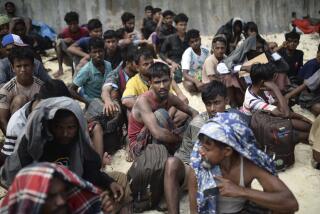16,000 Boat People Crowd Squalid Camp
- Share via
GALANG, Indonesia — More than 16,000 refugees from Indochina have been crowded onto this 63-square-mile island, turning it into a noxious, fetid marsh, and 100 new ones arrive every day.
The island, in the Riau chain near Singapore, was opened as a refugee camp in 1979 to house no more than 6,000 to 8,000 people with firm commitments to be resettled in third countries.
Lt. Col. Doekseno told 24 journalists, during the first official tour of Galang since 1984, that the number of refugees on the island had risen from fewer than 2,000 in March, 1989, to 16,800.
Cramped, squalid conditions have created serious threats of disease and death, said Doekseno, one of the senior officials who run the island jointly with the office of U.N. High Commissioner for Refugees.
Garbage and dirty water from patched bathrooms and kitchens have turned the camp areas, where refugees live in barracks and makeshift tents, into stinking swamps.
A water shortage and the steadily increasing camp population have forced authorities on Galang to cut the water ration from 20 liters a day per person to seven. The weekly food allowance per refugee is 2.5 kilograms of rice, about 5 1/2 pounds, and two cans of sardines.
Indonesia’s problem is compounded by a new flow of “boat people” from Cambodia, who began arriving in February and now total more than 1,500.
At least seven boatloads of Cambodians bound for Australia have landed in Indonesia since May, Doekseno said. Some were sent to Galang and others continued on their way after being given food and fuel.
Indonesia does not recognize the Cambodians as refugees and treats them differently at the Galang camps. Doekseno said they are classified as “displaced persons” in order to qualify them for some help from the U.N. refugee agency.
Foreign Minister Ali Alatas described them as “economic migrants” who should be repatriated.
Indonesian officials said the Cambodians left home with Australia as their clear destination, carrying money and traveling in good boats. Doekseno denied claims by Australia that Indonesia refuses to let Cambodians land, and said: “We accept them . . . on humanitarian grounds.”
Cambodians on Galang have built their own village on a hill. They tried to make homes similar to those they left behind, using palm fronds, mud and whatever other building materials the island offered.
Long Rithida, 23, said she left her mother behind in Cambodia and was trying to reach relatives in Australia or Canada.
“I don’t want to go back to Cambodia,” she said. “My uncle is in Canada and my aunt is in Australia. I want to live in a free country.”
She arrived in late February in a boat with 81 other Cambodians.
Australia, concerned about the increasing flow of boat people, wants Indonesia to continue its role as a country of first asylum, where refugees are screened and sent to their countries of final settlement: the United States, Australia and European nations.
More to Read
Sign up for Essential California
The most important California stories and recommendations in your inbox every morning.
You may occasionally receive promotional content from the Los Angeles Times.













